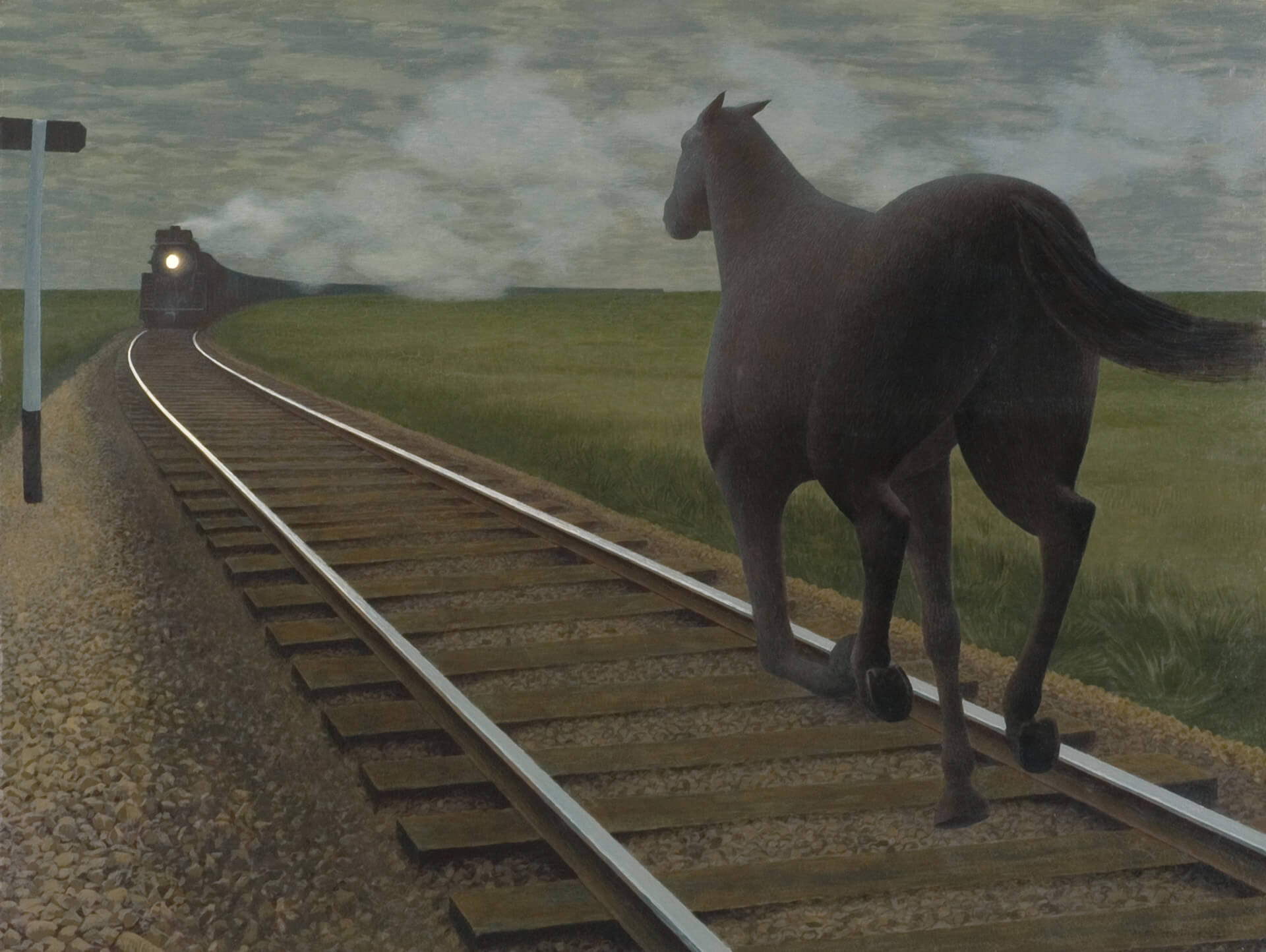/Horse And Train
A Reflection on the Clash Between Nature and Technology
from 08/24/2024, by uni — 5m read
"Against a regiment I oppose a brain, And a dark horse against an armored train." - Roy Campbell

Two seconds away from disaster. This is the immediate, visceral feeling that Alex Colville's painting "Horse and Train" invokes. The concept of the dark horse traditionally represents an underdog, someone or something unlikely to succeed. Colville frames this David-and-Goliath-like scene strikingly: the illuminated horse appears almost ten times larger than the steel train it is running towards. Yet, this exaggerated scale does nothing to change the sense of impending doom. Without depicting any explicit violence, Colville allows us to imagine the gruesome, bloody aftermath.
In 1954, when Colville created this painting, he had just returned from serving in the Canadian Army during World War II, where he worked as an official war artist, capturing the grim realities of places like the Bergen-Belsen concentration camp. Like many who served, Colville experienced firsthand the horrors of the modern world. It is no secret that some of the greatest technological innovations in human history were born out of warfare. This prompts a troubling question: How could we have harnessed the greatest minds of our time to create tools primarily for killing? Colville's composition seems to reflect these tensions between our manufactured society and the human spirit.
Our systems and technologies have begun evolving faster than our brains can keep pace with. Modern life has accelerated far beyond the capabilities of our biological selves. Homo sapiens emerged approximately three hundred thousand years ago, with survival as our primary concern - farming, cooking, living. The industrial revolution took place just two hundred and fifty years ago, and the digital revolution is barely fifty years old. Consider how much change our species has endured in just a few generations. We are still running on "old hardware" but living in a completely new environment, oblivious to the fact that we may be blindly setting ourselves up for failure.
It seems paradoxical that in a modern world where technology is designed to make life easier and more efficient, we face skyrocketing rates of anxiety and depression1. Not only are we threatening our own existence, but we are also jeopardizing the natural world around us. According to Colville's painting, it's just a matter of when, not if.
"It has become appallingly obvious that our technology has exceeded our humanity." - Albert Einstein
How much more can our brains adapt? In our society, those fortunate enough to thrive in this rapidly changing environment often do so at the expense of others, who may find themselves left behind. In major American cities, mental illness is rampant, and passersby often avert their eyes from the harsh realities of life on the streets2. Humans have become addicted to thinking, with algorithms on social media shaping how we perceive ourselves and the world around us. The relentless pace of technological advancement has fostered a culture of perpetual productivity, where the pressure to constantly be "on" has led to widespread burnout. Our political structures instill a constant sense of anxiety, leaving many to feel that our creations have somehow started to control us.
This is not a call for a "Unabomber-esque" return to a hunter-gatherer society. I enjoy sitting in my air-conditioned room, and I love my computer3! Technology is an intrinsic part of who we are - Homo sapiens, "thinking man." From the moment we discovered how to create fire by striking two rocks together, we have relied on technology to survive and thrive. Yet, like fire, technology must be used responsibly. The dark horse in Colville's painting, literally on track for disaster, still has time to change course. We may be the destroyers of this world, but we have the power to cultivate it as well.
-
Effects of cumulative COVID-19 cases on mental health: Evidence from multi-country survey ↩
-
The 2020 Annual Homeless Assessment Report (AHAR) to Congress ↩
-
Can't wait to stop working on my work computer and start playing on my play computer. pic ↩